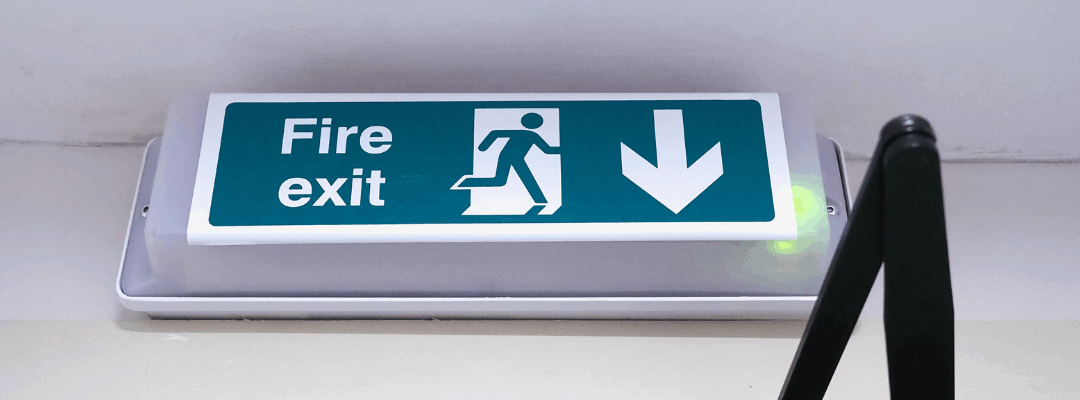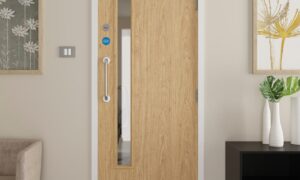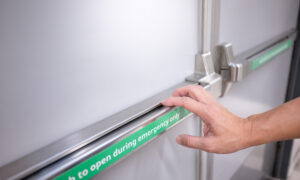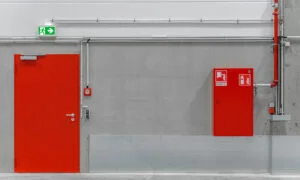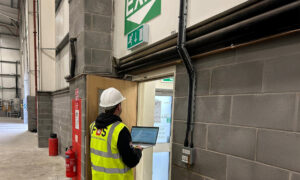If you’re responsible for the safety of a non-domestic building — whether it’s a factory, a school or a retail unit — fire doors are essential. These doors are part of your passive fire protection system and they play a critical role in protecting lives and property.
But how do fire doors actually work? Here, we’ll take a look at fire door materials and functionality. We’ll be covering:
- What is a fire door?
- Fire door components
- How do fire doors work?
- How long do fire doors work for?
- What are fire doors made from?
- Where should fire doors be installed?
- How to keep fire doors in good working order
What is a fire door?
A fire door is a specially designed door system that helps contain fire and smoke for a set period — usually 30, 60, 90 or 120 minutes.
This gives people enough time to evacuate safely. It also makes it more likely that the fire brigade can gain control of the fire before it spreads to other parts of the building.
Fire door components
A fire door doesn’t just consist of fire-resistant door panels. It’s a complete system, made up of:
- A certified fire-rated door
- Intumescent strips (which expand when heated to block gaps and prevent smoke from seeping between rooms)
- Fire-rated hardware like hinges, latches and closers
- A properly fitted frame
- Self-closing mechanism
- Fire-rated glazing (if your door includes a vision panel)
When installed correctly, these elements work together to slow the spread of fire, heat and smoke. They help to save lives and significantly reduce damage.
How do fire doors work?
So we know the elements that go into a fire door system. But how do those elements work together to protect your people and premises?
In the case of a fire, here’s how a fire door functions:
1. Contains fire and smoke
The primary way a fire door works is through compartmentation. That means keeping fire and smoke sealed in one area, preventing it from moving quickly into another.
Intumescent strips are rubber seals around a fire door. These strips expand under high temperatures (around 200°C), sealing the gaps around the door to block smoke and flames.
Some doors are also fitted with cold smoke seals. These prevent smoke from spreading between rooms before the fire gets hot enough to activate the intumescent strips.
2. Protects escape routes
Strategically placed fire doors help prevent fire and smoke from entering emergency exit routes. By keeping these routes clear, occupants of the building can escape safely in the event of a fire.
3. Self-closes to maintain protection
Most fire doors are fitted with self-closing mechanisms. They shut automatically after being opened. This is essential because — if a fire door is left open — it’s useless as a fire defence system.
It’s only when the door is shut that it can function as a barrier and create the necessary seal between the door and the doorframe.
In some settings — like hospitals or care homes — automatic fire doors are used.
These doors stay open during normal use but close automatically when a fire alarm is triggered. They offer the same level of fire protection while allowing people and equipment to move easily around the building.
How long do fire doors work for?
The amount of time a fire door can withstand fire, smoke and heat depends on its FD rating.
FD ratings tell you how long the door will resist fire under test conditions. These tests are conducted by a certified third-party organisation. Doors then receive one of the following ratings:
- FD30: 30 minutes
- FD60: 60 minutes
- FD90: 90 minutes
- FD120: 2 hours
- FD240: 4 hours
- FD360: 6 hours
A higher rating is typically used in high-risk environments or areas that need more time for evacuation, like high-rise buildings, hospitals or factories with hazardous materials.
It’s important to note that the fire rating only applies if the door is installed and maintained properly. A badly fitted FD60 door might perform worse than a correctly fitted FD30.
What are fire doors made from?
Fire doors can be made from a variety of materials. The materials you choose will depend on where you’re using the door and the level of fire protection you need.
Some different types of fire doors include:
- Timber fire doors: Often used in offices, schools and apartment blocks. Timber fire doors are made from solid hardwood or composite cores and are usually coated in intumescent paint or laminate.
- Steel fire doors: More common in industrial and commercial settings, steel fire doors are robust, secure and can be rated up to FD360.
- Glazed fire doors: These doors include specialist fire-rated glass. They’re often used in offices or communal areas where visibility is a priority.
- Fire curtains: Fire curtains aren’t technically fire doors. But they serve a similar purpose in large open-plan areas.
No matter the material, all fire doors must be certified to a specific FD rating.
Where should fire doors be installed?
Fire doors are required in various locations depending on your building’s size, use and layout. Common fire door locations include:
Along stairwells, corridors and lobbies to protect escape routes
At the entrance to high-risk areas — for example, kitchens, electrical rooms, rooms that contain flammable materials or chemicals
In compartment walls, to create a barrier and separate different parts of the building in case of a fire
A fire survey can help you determine where fire doors are required in your building — and if existing doors are up to scratch.
How to keep fire doors in good working order
Fire doors only work if they’re properly maintained. Over time, seals wear out, hinges loosen and self-closers fail.
So to keep everything working as it should, fire doors should be inspected at least every six months. As part of the inspection, a competent person needs to:
- Check for damage to seals and glazing
- Ensure the door closes fully and latches shut
- Make sure hinges, locks and closers are working correctly
Bear in mind that even small gaps or warping can dramatically reduce a fire door’s effectiveness. So, to ensure your fire door functions perfectly, you need to stick closely to your fire door maintenance schedule.
Find the right fire doors for your business with Fire Door Systems
At Fire Door Systems, we design, supply and install certified fire doors for commercial and industrial environments — from strong steel fire doors for factories to glazed timber fire doors for offices.
We also provide a professional fire door maintenance service, helping our customers abide by fire safety regulations and keep their people and premises safe.
Need a quote or fire door advice? Get in touch today and speak to a member of our expert team.
